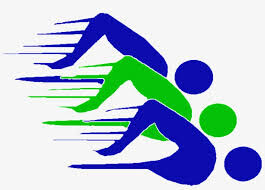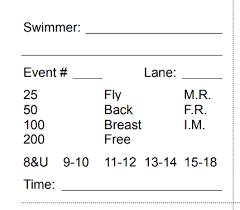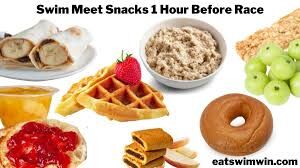NRST Parent Guide

Contents
Introduction
Signing up for a meet
What to bring for your swimmer
What to bring for you
Arriving at the pool
What is a heat sheet and how do I read it?
Swim Meet Warm Ups
Short Course and Long Course Explanation
Multiple Pool and Multiple End Meets
Qualifying time standards…what are they?
Personal best times
Officiating
APPENDIX 1 – Healthy Snacks
INTRODUCTION
I have been around competitive swimming most my life. Throughout this time, I have answered many questions from parents regarding the procedures of a regular swim meet. It was recently suggested that a guide explaining the ins and outs of a competitive swim meet should be provided to all parents new to swimming. This would ensure that everybody knows what to expect and will allow for a more enjoyable swim meet experience.
SIGNING UP FOR A MEET
Your swimmer’s coach will provide you with the meet information. It is important that you declare or decline your swimmer online. All swim meets have entry deadlines. This deadline is approximately 5-7 days prior to the start of the event. Coaches need to submit entries by the given deadline in order for the entries to be accepted. It is, therefore, essential that you submit your swimmer's declaration, on time, to ensure that your swimmer will be entered.
Swim Canada (the governing body for the sport of swimming in Canada) requires clubs to register swim meets and to seek a sanction from a certified official. These procedures ensure that meets are conducted fairly and according to the rules and standards of the governing body. Every registered meet in Canada can be located at www.swimmeet.ca. You can search meets by season, province, region, club, short/long course or simply type in what you are looking for in the search box.
If for some reason you are unable to attend a meet for which you are signed up, let your swimmer’s coach know so they can scratch your swimmer from the meet. Some meets have scratch deadlines after which the host club will levy a fee for any events not swum. Letting your swimmer's coach know that you can not attend as soon as possible will help prevent the accumulation of fees.
WHAT TO BRING FOR YOUR SWIMMER
• Your swimmer(s) will be in and out of the water several times throughout the course of the day. Therefore, it is important that they bring several towels so they can dry off adequately and stay warm.
• Team gear - Show your team spirit and come dressed in team clothing, or clothing of your team’s colors. Many swimmers have hoodies and sweat pants that they wear between events. This ensures that their muscles stay warm.
Healthy snacks are important to maintain your swimmer’s energy levels for their races. I have attached a list of good snack choices in the appendix of this guide.
• Water bottle – swimmers need to stay hydrated in order to perform their best.
WHAT TO BRING FOR YOU
• A collapsible chair will quickly become your best friend as a swim parent. It will only take one meet sitting on bleachers with a stranger’s knees in your back to make sure you never forget this valuable piece of equipment ever again.
• Bring some money to buy a heat sheet so that you can follow along with the meet and know when your child is swimming. The host club usually places heat sheets on a table by the entrance to the spectator gallery or, in some other obvious location. They usually cost around $2. If you are at a meet that has preliminaries and finals it’s a good idea to save your morning heat sheet (containing preliminaries) as it can be traded for a finals heat sheet later that night.
• Water bottle - pools are hot and humid; it is a good idea to keep hydrated so your child does not have to wake you up to ask if you saw their race.
• Depending on the size of the meet, you may want to bring a book or something to occupy yourself with between your child’s swims. The larger the meet the longer your child will have between events. At large competitions, like provincials, the interval can sometimes range from 45min to an hour.
• An encouraging attitude - I am continually shocked at the number of parents who I see berating their swimmer for poor performance. A swim meet is no place to focus on the negative aspects of a swim. Your child’s coach will review their swim with them at the end of their race.
• Highlighter - it is a good idea to follow the meet by marking your swimmer’s races on your heat sheet.
ARRIVING AT THE POOL
Once you arrive at the pool your swimmer can get changed and head out on deck. Your swimmer should locate their team members and check in with the coach for the meet. The meet coach will inform them of their events for the day and will answer any questions or concerns your swimmer(s) may have. The meet coach may not necessarily be your swimmers regular practice coach as there are occasionally two or more meets held in different locations on the same weekend. More experienced swimmers on the team will lead your swimmer through a stretching routine until the pool opens for warm up. Most swim meets have a one-hour warm up period that usually occurs the hour prior to the stated start time. This is when the recommended book may come in handy. Heat sheets will be for sale prior to the start of the meet. An explanation of how to read a heat sheet is contained in the next section.
WHAT IS A HEAT SHEET....
AND HOW DO I READ IT?

Earlier in the guide, I explained how coaches are required to submit all entries by a deadline designated by the host club. These entries tell the host club what events each swimmer from a visiting team would like to swim. There are thirteen events in the sport of swimming. Events are defined by the sex and age of the swimmers as well as the stroke (or combination of strokes) and the distance to be swum. Once the host club receives the entries, they enter them into a computer program called Meet Manager. The program first sorts all entries by event. Within each event, athletes are listed according to their entry time. Swimmers are then placed into groups the size of which is determined by the number of lanes in the host pool (often this is 8). These groups are called heats. Within each heat, swimmers are placed into lanes in accordance with their entry time. Lane 4 is designated for the fastest entry time in the heat. The program will seed (place) swimmers fastest to slowest in the following lane order 4,5,3,6,2,7,1,8. Some meets run heats fastest to slowest while others run slowest to fastest; some alternate boy’s heats and then girl’s heats. Every meet is different but this should provide you with a general understanding of what to expect.
Before the start of the meet, your swimmer’s coach will explain to your swimmer how the meet will be run. Your swimmer will not have an entry time at their first meet. On the heat sheet under the seed time (entry time) category there will be an NT which stands for no time. All swimmers who have never competed in a meet will be in this heat. For example, Bell E. Flopp as shown on the heat sheet above may be a faster swimmer than Abbie Birthday. Because Bell has not swum at a meet before, the computer has no idea where to place her and therefore automatically places her in the first or slowest heat. The number in front of the swimmers name is the lane number in which the swimmer will be competing. The heat number, age, team and seed time are all self-explanatory.
Some meets will have an estimated start time for each event. Remember that these times are estimations only and do not guarantee when the event will actually occur.
SWIM MEET WARM UPS
Depending on the number of participants and calibre of the meet, be prepared for some chaos. At some meets there are hundreds of swimmers trying to warm up in the same pool at the same time. This feat could also be called organized pandemonium. Warm ups are normally swum in the hour prior to the official start time of the meet. Some meets have a 15 min buffer zone between the end of warm up and the start of the meet. Lanes 1 and 8 become dive lanes 20 min prior to the finish of warm up. This allows swimmers to get used to the starting blocks and prepare to swim fast.
SHORT COURSE AND LONG COURSE EXPLANATION
Short course swimming is done in 25m pools. Short course meets make up the first half of the competitive season. Long course swimming is done in a 50m pool. In Canada, the long course season is the second half of the competitive season. Long course is used at the Olympics and most major competitions in the sport of swimming.
MULTIPLE POOLS AND MULTIPLE END MEETS
As a new swim parent you will probably be very comfortable with swim meets by the time you encounter a multiple pool meet. Provincial and national level meets are usually held in venues with multiple pools and often run with more than 400 swimmers. Heat sheets for the meet will tell you which pool is being used for the males and which one for females. Most pools have a north/south east/west type description of their pools. Long course meets will sometimes run males and females from different ends. Races are swum concurrently, that is there are two races going on in the same lane at one time. Not to worry, they are timed to allow room for swimmers to exit the water and clear the way so as not to interfere with either swim.
QUALIFYING TIME STANDARDS…WHAT ARE THEY?
Qualifying time standards are set by the provincial governing body for the sport of swimming. In British Columbia, this body is Swim BC. Time standards are broken down by age and sex. Some meets require that a swimmer have a specified time in order to compete. You can ask your swimmer’s coach for a printout of his or her best times to compare with the time standards that can be found on the Swim BC website www.swim.bc.ca. Your swimmer’s coach will know if your swimmer has achieved these times. Some meets will require that swimmers have a qualifying time standard in order for them to compete. Other meets will prohibit, or dequalify those with a certain time standard from competing. This ensures a better swim meet experience for all participants as they will be swimming against swimmers of similar ability.
PERSONAL BEST TIMES
Heat sheets will have your swimmer's personal best time recorded. This information is a good way to help motivate your swimmer to concentrate on improving their best performance rather than on final placing or medal counting.
OFFICIATING
As mentioned earlier some swim meets can have long stretches of inactivity where your swimmer is not in the water. In order to keep your interest, why not participate as a meet official? Most clubs offer training on becoming a swim official and need your help. Officiating is your cure for boredom. Swim meets require an extensive amount of planning and organization. They also require many volunteers. Below is a list of the minimum number of people required to run a typical swim meet.
• 1 referee
• 1 starter most meets have 2
• 10 stroke and turn judges
• 1 chief timer
• 16 lane timers
• 1 clerk of course
• 1 meet manager
• 1 person on the electronics (touch pads)
• 1 person to enter results data into computer
• 2 safety marshals
• 1 Runner to collect lane times from timers
Swim meets also involve food preparation, food service, award preparation, set up and take down. The more volunteers there are for a meet, the better a meet will run which will only benefit your children.
APPENDIX 1 Healthy Snacks
All athletes need to eat a variety of different foods. Keep in mind these four categories when packing meals and snacks:

Protein
Found in meat, eggs, and dairy foods
Carbohydrates
Fruits, vegetables, and whole grain food products are your best choice
Vitamins
Found in fruits and vegetables
Minerals
Calcium for example- found in dairy products
• Examples of Protein snacks include trail mix (with nuts), sandwiches (meat or high protein vegetables such as beans or Asparagus). Google search high protein snacks for more ideas.
• Whole grain carbohydrates are your best choice, as they will not spike blood sugar levels the way refined products will. Fruits and veggies are always a quick and easy choice for this category.
• Kids need a variety of vitamins and minerals. Calcium and iron are two important minerals for athletes. Calcium helps build strong bones to resist breaking and stress fractures. Calcium-rich foods include dairy products like milk, yogurt and cheese, as well as leafy green vegetables such as broccoli. Iron helps carry oxygen to all the different body parts that need it. Iron-rich foods include red meat, chicken, tuna, salmon, eggs, dried fruits, leafy green vegetables, and whole grains. Drink Up! • It's important for young athletes to drink plenty of fluids in order to prevent dehydration, which will deplete strength, energy, and coordination and can lead to heat-related illness such as heat stroke. Even mild dehydration can affect negatively athletic performance. • Thirst is not a reliable indicator of hydration status. Experts recommend that kids drink water or other fluids every 15 to 20 minutes during physical activity. All NRST coaches recommend water bottles during practice.
Drink Up!
• It's important for young athletes to drink plenty of fluids in order to prevent dehydration, which will deplete strength, energy, and coordination and can lead to heat-related illness such as heat stroke. Even mild dehydration can negatively affect athletic performance.
• Thirst is not a reliable indicator of hydration status. Experts recommend that kids drink water or other fluids every 15 to 20 minutes during physical activity. All NRST coaches recommend water bottles during practice.
• Although many sports drinks are available, plain water is usually enough to keep kids hydrated. Sports drinks are designed to provide energy and replace electrolytes — such as sodium and potassium — that athletes lose in sweat.
• Sports drinks are a good choice if kids are active for more than 1 hour, as the body has used up its readily available sources of energy. Sports drinks are also a good alternative if kids aren't drinking enough water.
• Diluted juice is another option but avoid carbonated beverages that can upset the stomach.